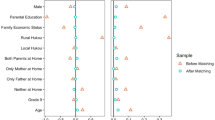Abstract.
When capital and labor markets are imperfect, choice sets narrow, and parents must choose how to ration available funds and time between their children. One consequence is that children become rivals for household resources. In economies with pro-male bias, such rivalries can yield gains to having relatively more sisters than brothers. Using a rich household survey from Ghana, we find that on average if children had all sisters (and no brothers) they would do roughly 25-40% better on measured health indicators than if they had all brothers (and no sisters). The effects are as large as typical quantity-quality trade-offs, and they do not differ significantly by gender.
Similar content being viewed by others
Author information
Authors and Affiliations
Additional information
Received: 22 May 1996 / Accepted: 13 July 1998
Rights and permissions
About this article
Cite this article
Garg, A., Morduch, J. Sibling rivalry and the gender gap: Evidence from child health outcomes in Ghana. J Popul Econ 11, 471–493 (1998). https://doi.org/10.1007/s001480050080
Issue Date:
DOI: https://doi.org/10.1007/s001480050080




